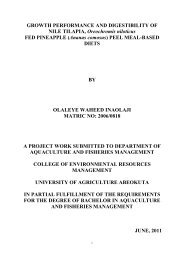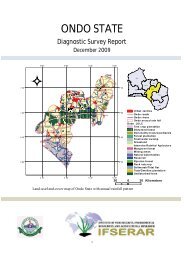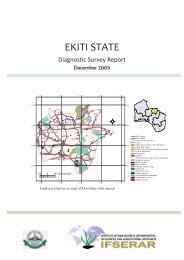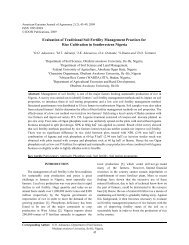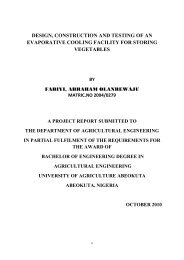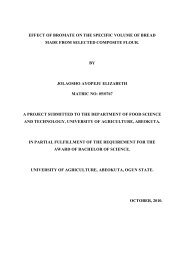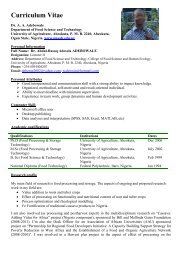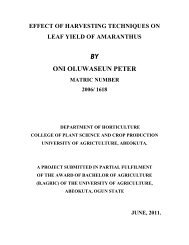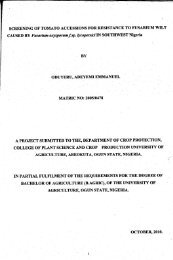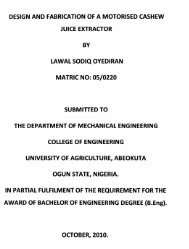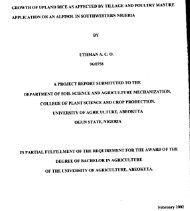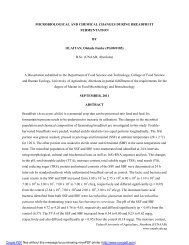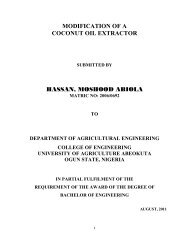ONWUNYI Chuks Atunegwu MATRIC NO 040093 Department Of ...
ONWUNYI Chuks Atunegwu MATRIC NO 040093 Department Of ...
ONWUNYI Chuks Atunegwu MATRIC NO 040093 Department Of ...
You also want an ePaper? Increase the reach of your titles
YUMPU automatically turns print PDFs into web optimized ePapers that Google loves.
EFFECT OF PROCESS PARAMETERS ON SOME PROPERTIES OF<br />
EXTRUDED SWEET POTATO (ORANGE FLESHED) STARCH<br />
<strong>ONWUNYI</strong> <strong>Chuks</strong> <strong>Atunegwu</strong><br />
<strong>MATRIC</strong> <strong>NO</strong> <strong>040093</strong><br />
<strong>Department</strong> <strong>Of</strong> Food Science And Technology,<br />
College of Food Science and Human Ecology,<br />
University <strong>Of</strong> Agriculture, Abeokuta.<br />
A Project Report Submitted In Partial Fulfillment of the Award<br />
of<br />
Degree of Bachelor of Science (B. Sc) in Food Science and<br />
Technology<br />
OCTOBER 2010
CERTIFICATION<br />
This is to certify that this project was carried out by Onwunyi <strong>Chuks</strong> <strong>Atunegwu</strong> with<br />
Matriculation number 2004/0093 and is approved in partial fulfillment of the requirement for<br />
the award of BSc. Degree of the <strong>Department</strong> of Food Science and Technology, College of<br />
Food Science and Human Ecology, University of Agriculture, Abeokuta, under our<br />
supervision.<br />
…………………………… ……………………………..<br />
…………………………… ….............................................<br />
………………………….. ……………………………….
DEDICATION<br />
This project work is dedicated to Almighty God for His greatness. The One who has kept me<br />
all through my years on earth. I cannot thank Him enough.
ACK<strong>NO</strong>WLEDGEMENT<br />
My sincere and unending gratitude goes to my wonderful, ever loving, caring parents, Mr.<br />
and Mrs. Wilfred Onwunyi for their parental, financial, moral, spiritual support from birth till<br />
now. I can’t pay you back for your efforts in moulding me into my great self but God will<br />
continually reward you and you will live to enjoy the fruits of your labour.<br />
I also acknowledge the suggestions, inputs and advice from my supervisor, Dr. (Mrs.) J.M<br />
Babajide as well as my co-supervisor Dr. O. P Sobukola and all lecturers in the <strong>Department</strong><br />
of Food Science and Technology who sacrificed all it took to see this project through. May<br />
God reward you bountifully. I also appreciate Professor Sanni for His input towards<br />
execution of the project analysis, may God bless you.<br />
I cannot end without thanking Uju (Paddy G), Mrs. Ebere Onyema, Chinasa, Uche. You all,<br />
worked tirelessly in helping me acquire and process the Sweet Potato sample: May you never<br />
lack manpower.<br />
To my great friends Osagie and Tayo, I thank God I met you. You have been a great source<br />
of inspiration to me on my path through UNAAB. I love you guys. To my Pastor, Femi<br />
Bankole, First class for me would have been a dream but for your fervent prayers. Good<br />
things will never elude you. This work will not be complete without mentioning the input of<br />
two great men Gbenga Soladoye (Prof Gee) and Oladimeji Jeyeola (Sir D) towards making<br />
sure I finished with a first class honours. May God bless you both.<br />
Finally to my classmates you have made the race worthwhile. What will I have done without<br />
you all. See you all at the top.
FIGURES<br />
LIST OF FIGURES<br />
1. Response surface plot of WAI as a function of temperature and moisture content 37<br />
2. Response surface plot of WSI as a function of temperature and moisture content 38<br />
3. Response surface plot of bulk density as a function of temperature and 39<br />
Moisture content<br />
4. Response surface plot of solid loss as a function of temperature and moisture content 40<br />
5. Response surface plot of lateral expansion as a function of temperature 41<br />
and moisture content
TABLE<br />
LIST OF TABLES<br />
1: Proximate Composition of Isolated Sweet Potato Starch 6<br />
2. Response surface analysis of functional properties of extruded 34<br />
sweet potato starch for all experimental.<br />
3. Coefficient of regression equation for the physicochemical 35<br />
properties of extruded sweet potato starch.
LIST OF PLATES<br />
1. Aerial view of an locally fabricated single screw extruder 23<br />
2. Extruder barrel 24<br />
3. Extruder screw 25
ABSTRACT<br />
The study investigated the effect of selected process parameters: barrel temperature (100-<br />
140 o C), feed moisture (50-60%), Screw speed (100-140rpm), on some properties of extruded<br />
sweet potato starch. Response surface methodology based on Box-Behnken design was used<br />
to optimize process variables. Seventeen combinations including three replicates of the<br />
central points were performed in random order for the independent variables. The results<br />
showed a range for Water Absorption Index (WAI) (2.42-2.81), Water Solubility Index<br />
(WSI) (0.65-0.98), Bulk Density BD (0.70-0.80), Lateral Expansion (LE) (0.8-1.02) and<br />
Solid loss (SL) (2.5-10.0). Increasing the barrel temperature results in higher Water<br />
Absorption Index (WAI), lower Water Solubility Index (WSI), Solid loss (SL), Lateral<br />
Expansion (LE) and bulk density (BD). Increased screw speed decreased WAI, BD but<br />
increased WSI. Feed moisture content had no significant effect on observed properties of<br />
extrudates. The optimum processing conditions necessary to obtain the desired quality pasta<br />
are combination of temperature of 100 o C, feed moisture of 60% and screw speed of 103.34<br />
rpm.
TABLE OF CONTENTS<br />
CONTENTS PAGES<br />
CERTIFICATION ii<br />
DEDICATION iii<br />
ACK<strong>NO</strong>WLEDGEMENT iv<br />
TABLE OF CONTENTS v<br />
LIST OF TABLES vi<br />
LIST OF FIGURES vii<br />
ABSTRACT viii<br />
CHAPTER ONE<br />
1.0 INTRODUCTION 1<br />
1.1 JUSTIFICATION 3<br />
1.2 OBJECTIVES 3<br />
CHAPTER TWO<br />
2.0 LITERATURE REVIEW 4<br />
2.1 SWEET POTATO 4<br />
2.2 EXTRUSION 5<br />
2.2.1 GENERAL DESCRIPTION OF AN EXTRUSION EQUIPMENT 7<br />
2.2.2 OPERATING CHARACTERISTICS OF AN EXTRUSION EQUIPMENT 10<br />
2.2.3 CHANGES IN FOOD AFTER EXTRUSION 11<br />
2.3 FOOD STARCH 13<br />
2.3.1 PROPERTIES AND STRUCTURE OF FOOD STARCH 15<br />
2.3.2 HYDROLYSIS OF FOOD STARCH 16<br />
2.3.3 DIGESTIBILITY AND DEXTRINIZATION OF FOOD STARCH 16<br />
2.3.4 STARCH AS FOOD 16<br />
2.3.5 USE OF STARCH AS FOOD ADDITIVE 17<br />
2.3.6 STARCH SUGARS 17
2.3.7 INDUSTRIAL APPLICATION OF FOOD STARCH 18<br />
CHAPTER THREE<br />
3.0 MATERIALS AND METHOD 21<br />
3.1 MATERIALS 21<br />
3.2 EQUIPMENT 21<br />
3.3 METHOD 21<br />
3.3.1 STARCH ISOLATION 21<br />
3.3.2 EXTRUSION COOKING 22<br />
3.4 PROXIMATE ANALYSIS OF ISOLATED SWEET POTATO STARCH 26<br />
3.4.1 DETERMINATION OF MOISTURE CONTENTOF ISOLATED 26<br />
SWEET POTATO STARCH<br />
3.4.2 DETERMINATION OF PROTEIN CONTENTOF ISOLATED 26<br />
SWEET POTATO STARCH<br />
3.4.3 DETERMINATION OF FAT CONTENTOF ISOLATED 26<br />
SWEET POTATO STARCH<br />
3.4.4 DETERMINATION OF ASH CONTENTOF ISOLATED 27<br />
SWEET POTATO STARCH<br />
3.4.5 DETERMINATION OF CABOHYDRATE CONTENTOF ISOLATED 27<br />
SWEET POTATO STARCH<br />
3.5 ANALYSIS ON EXTRUDATES 27<br />
3.5.1 WATER ABSORPTION INDEX 28<br />
3.5.2 WATER SOLUBILITY INDEX 29<br />
3.5.3 BULK DENSITY 29<br />
3.5.4 SOLID LOSS 29<br />
3.5.5 LATERAL EXPANSION 29<br />
3.6 STATISTICAL ANALYSIS ON FUNCTIONAL PROPERTIES 30<br />
OF EXTRUDATES
CHAPTER FOUR<br />
4.0 RESULTS AND DISCUSSION 31<br />
4.1 PROXIMATE COMPOSITION OF ISOLATED SWEET POTATO STARCH 31<br />
4.2 RESPONSE SURFACE ANALYSIS OF FUNCTIONAL PROPERTIES OF 31<br />
EXTRUDED SWEET POTATO STARCH<br />
CHAPTER FIVE<br />
5.0 CONCLUSION AND RECOMMENDATION 43<br />
5.1 CONCLUSION 43<br />
5.2 RECOMMENDATION 43<br />
REFERENCES 44
CHAPTER ONE<br />
1.0 INTRODUCTION<br />
Extrusion processing is a form of manufacture that involves the forcing of a material out of<br />
chamber or cylinder through a small opening by taking advantage of pressure differentials<br />
that exist between the internal and exterior of the chamber. Extrusion cooking involves the<br />
cooking, texturizing and shaping of a wide range of plant and animal food raw materials in a<br />
continuous operation (Nielsen, 1976). Extrusion cooking of starchy materials has become a<br />
widely used technique to obtain a wide range of products such as snacks, breakfast, cereals,<br />
special flours (for instant soup mixes, porridge etc) (Harper, 1989, Guy and Bouvier, 1996,<br />
Bouzaza et al., 2000).<br />
Consequent upon the pressure build up during fluid flow of material through the die, high<br />
shear stresses are developed which causes structural transformation in the material. These
transformations include: Loss of starch crystalline structure, destruction of granular structure,<br />
rupture of glycosidic bonds and new molecular interactions (Davidson, 1992; Mitchell and<br />
Areas, 1992 Gonzalez et al., 2002). As the product leaves the die, it is in a glassy state. It<br />
expands rapidly and as it cools, the temperature falls below the glass transition state and<br />
strands as well as matrices form that set the structure and determines the product texture<br />
(Blanshard, 1995). The rapid release of pressure as the food emerges from the die, causes<br />
instantaneous expansion of steam and gas in the material to form a low density product.<br />
Products can vary considerably depending on extruder type, operation parameters (moisture<br />
content, screw length and speed, die diameter, temperature), type of feed material and feed<br />
rate.<br />
The principal food materials that could undergo extrusion are: all cereal grains, oilseeds and<br />
legumes. An increasingly important role of food extruders are assured in the food processing<br />
industry because of an increasing world population and shrinking conventional energy<br />
supplies (Harper, 1989). These trends focus on the need to transform raw agriculture products<br />
into foods of high acceptability. The versatility of extruders in combining a series of other<br />
unit operations some of which are kneading, mixing, shearing, shaping and texturizing makes<br />
them ideally suited for this task especially in less developed countries as well as developing<br />
countries: Nigeria inclusive.<br />
Sweet potato (Ipeoma batatas) is an important crop of many developing countries. Although<br />
sweet potato originated from Central America, its ability to adapt to a wide variety of climatic<br />
conditions, allows them to grow both in tropical and moderate temperate regions of Africa,<br />
Asia and America (Woolfe, 1992). Villareal (1977) cited five reasons which favour sweet<br />
potato utilization in today’s diet. These include the tremendous yield potential, high nutrient<br />
yield per hectare, dependability, due primarily to its drought tolerance and ability to<br />
withstand typhoon conditions and acceptability to consumers because of its palatability and
low cost. Sweet potatoes are rich in starch (6.9- 30.7%) on wet basis (Tian et al., 1991) and<br />
starch production is a main industrial utilization of sweet potato.<br />
Varieties of sweet potato in Nigeria include the orange fleshed variety-TIS- 1499 and the<br />
TIB- 2. Sweet potato starch granules are reported as round, oval and polygonal shapes with<br />
sizes ranging between 2- 42µm (Tian et al., 1991; Hover 2001). Swelling and solubility of<br />
sweet potato starch are less than those of cassava and potato starch.<br />
Love et al., (1983), Akinyele (1987) and Dashiell et al., (1990), reported on potential<br />
application of extrusion cooking in Nigeria, there is however, a dearth of information on the<br />
application of extrusion cooking to sweet potato (Iwe, 1998), despite the fact that sweet<br />
potato is one of the most versatile energy and vitamin producers in the world (Woolfe, 1992).<br />
The use of cooker extruders has been expanding rapidly in the food and feed industries over<br />
the past few years there is however a need to study its effects on sweet potato starch due to its<br />
increased consumption.<br />
1.1 JUSTIFICATION<br />
Dearth of information on the application of extrusion cooking on processing of sweet potato<br />
hence a need to explore the possibility of applying extrusion cooking to creating a diversified<br />
means of processing sweet potato.<br />
1.2 OBJECTIVE<br />
To determine the effect of process parameters (moisture content, temperature and<br />
screw speed) on some properties of extruded sweet potato starch.<br />
To determine the combination of process parameters that produce high quality<br />
extrudates
2.0 LITERATURE REVIEW<br />
2.1 SWEET POTATO<br />
CHAPTER TWO<br />
The sweet potato (Ipomoea batatas) is a dicotyledonous plant that belongs to the family<br />
Convolvulaceae. Its large, starchy, sweet tasting tuberous roots are an important root<br />
vegetable (Purseglove, 1991; Woolfe, 1992). The young leaves and shoots are sometimes<br />
eaten as greens. <strong>Of</strong> the approximately 50 genera and more than 1,000 species of<br />
Convolvulaceae, I. batatas is the only crop plant of major importance. This plant is a<br />
herbaceous perennial vine, bearing alternate heart-shaped or palmately lobed leaves and<br />
medium-sized sympetalous flowers. The edible tuberous root is long and tapered, with a<br />
smooth skin whose colour ranges between red, purple, brown and white. Its flesh ranges from<br />
white through yellow, orange, and purple.
The plant does not tolerate frost. It grows best at an average temperature of 24 °C (75 °F),<br />
abundant sunshine and warm nights. Annual rainfalls of 750–1000 mm are considered most<br />
suitable, with a minimum of 500 mm in the growing season. The crop is sensitive to drought<br />
at the tuber initiation stage 50–60 days after planting and is not tolerant to water-logging, as it<br />
may cause tuber rots and reduce growth of storage roots if aeration is poor (Ahn, 1993).<br />
Depending on the cultivar and conditions, tuberous roots mature in two to nine months. They<br />
are mostly propagated by stem or root cuttings or by adventitious roots called "slips" that<br />
grow out from the tuberous roots during storage. True seeds are used for breeding only.<br />
Under optimal conditions of 85 to 90% relative humidity at 13 to 16 °C (55 to 61 °F), sweet<br />
potatoes can keep for six months. Colder temperatures injure the roots. They grow well in<br />
many farming conditions and have few natural enemies; pesticides are rarely needed. Sweet<br />
potatoes are grown on a variety of soils, but well-drained light and medium textured soils<br />
with a pH range of 4.5-7.0 are more favourable for the plant (Woolfe, 1992; Ahn, 1993).<br />
They can be grown in poor soils with little fertilizer. However, sweet potatoes are very<br />
sensitive to aluminium toxicity and will die about 6 weeks after planting if lime is not applied<br />
at planting in this type of soil (Woolfe, 1992). Because they are sown by vine cuttings rather<br />
than seeds, sweet potatoes are relatively easy to plant. Because the rapidly growing vines<br />
shade out weeds, little weeding is needed, and farmers can devote time to other crops. In the<br />
tropics, the crop can be maintained in the ground and harvested as needed for market or home<br />
consumption. In temperate regions, sweet potatoes are most often grown on larger farms and<br />
are harvested before first frosts.<br />
Besides simple starches, sweet potatoes are rich in complex carbohydrates, dietary fiber, beta<br />
carotene (a vitamin A equivalent nutrient), vitamin C, and vitamin B6. Pink and yellow<br />
varieties are high in carotene, the precursor of vitamin A.
Sweet potato has various applications and uses. It can be processed into various products for<br />
both industrial and small scale use for consumption. One of such processing methods is<br />
extrusion.<br />
2.2 EXTRUSION<br />
Extrusion processing is a form of manufacture that involves the forcing of a material out of<br />
chamber or cylinder through a small opening by taking advantage of pressure differentials<br />
that exist between the internal and exterior of the chamber. Extrusion cooking, hence,<br />
involves the cooking, texturizing and shaping of a wide range of plant and animal food raw<br />
materials in a continuous operation (Nielsen, 1976). Extrusion is a highly versatile unit<br />
operation that can be applied to a variety of foods as shown in Table 1.<br />
TABLE 1: FOOD APPLICATION OF EXTRUSION COOKING<br />
Types of product Examples<br />
Cereal-based products Expanded snackfoods, RTE and puffed breakfast<br />
cereals, Soup and beverage bases, instant drinks,<br />
Weaning foods, Pre-gelatinised and modified<br />
starches, dextrins, Crispbread and croutons,<br />
Pasta products, Pre-cooked composite flours<br />
Sugar-based products Chewing gum, Liquorice Toffee, caramel,<br />
peanut brittle, Fruit gums
Protein-based products Texturised vegetable protein (TVP), Semi-moist<br />
and expanded petfoods and animal feeds and<br />
protein supplements,Sausage products,<br />
frankfurters, hot dogs, Surimi, Caseinates,<br />
Processed cheese.<br />
Adapted from Harper (1979), Harper (1987), Heldman and Hartel (1997), Jones (1990) and<br />
Best (1994).<br />
Extrusion cooking is performed by a cooker extruder. There major parts include the die,<br />
barrel, feed hopper, screw etc. the type of extruder used certainly affects chemical reactions.<br />
Larger extruders have longer barrels and relatively longer residence times than smaller table<br />
top or laboratory scale extruders. Small extruders require considerably less feed due to the<br />
lower through put, offering a definite advantage for preliminary studies using ingredients<br />
available only in small quantities. Various process parameters on both products and the<br />
extruder can affect the final product characteristics. These include the product feed rate,<br />
moisture content, die diameter, screw speed, temperature and flow rate of thermal fluid to<br />
barrel jackets. Various chemical and nutritional changes occur in food during extrusion. Few<br />
general chemical or physicochemical changes can occur during extrusion cooking: binding,<br />
cleavage, loss of native conformation, recombination of fragments and thermal degradation.
A major difference between extrusion and other forms of food processing is that<br />
gelatinization occurs at much lower moisture levels (12- 22%). Waxy or high- amylopectin<br />
corn starch extrusion is dominated by melting, which flows from zero order kinetics, instead<br />
of gelatinization, which is a first order reaction (Qu and Wang, 1994)<br />
2.2.1 GENERAL DESCRIPTION OF EXTRUSION EQUIPMENT<br />
Extrusion equipment can be classified thermodynamically or by pressure development in the<br />
extruder. According to the former classification, we have<br />
1. Autogenous extruder which converts mechanical energy to heat energy during the flow<br />
process.<br />
2. Isothermal extruder in which a constant temperature is maintained throughout the extruder<br />
3. Polytropic extruder that operates between extreme conditions of the autogenous and<br />
isothermal extruders.<br />
If classified by the manner in which pressure is developed, there are<br />
1. Direct or positive displacement type which include the Ram or piston type extruder and the<br />
inter-meshing counter-rotating twin screw extruder.<br />
2. Indirect or viscous drag type which include roller type extruders, single screw extruders,<br />
intermeshing co-rotating twin screw extruder and non intermeshing multiple screw extruder.<br />
The main components of the extrusion equipment include<br />
1. Drive: The drive has an AC or DC motor which is used to rotate the extruder screw in the<br />
barrel. The drive motor also comes with a transmission and a speed variation device for<br />
controlling the screw rotation speed. Depending on the capacity, the size of the motor can be<br />
as small as a few horse power for a laboratory-type extruder or several hundred horse-power<br />
for commercial extruder for full scale production.<br />
2. Feed assembly: The feed assembly consists of dry ingredient and liquid ingredient feeders.<br />
Pre-blended dry ingredients are held in hoppers or bins above feeders, which can be
vibratory, variable speed auger, or loss-in-weight type. Liquid ingredients are metered<br />
through positive displacement pumps, variable orifice, variable head, or water wheels. If a<br />
pre-conditioner is used, dry ingredients are mixed with water, steam, or other ingredients in a<br />
closed vessel, which can be operated under pressure if needed. The uniform feeding of dry<br />
and liquid ingredients is imperative for the consistent operation of an extruder.<br />
3. Screw: The screw can be one piece or consist of many individual screw elements<br />
assembled in a screw shaft. The screw is usually divided into feed, transition, and metering<br />
sections for single-screw extruders. The feed section has deeper flights to accept the food<br />
ingredients from the feeder. In the transition section, the food ingredients are mixed, heated,<br />
and worked into a continuous mass. Thus, the transition section is also called the compression<br />
section because the materials are changed from a loose, powdery state into a plasticized<br />
dough. This is accomplished by<br />
gradually decreasing flight depth or pitch in the direction of discharge,<br />
heating from the barrel, and<br />
Working of the feed material to generate frictional heat.<br />
The metering section has shallow flights that increase the shear rate; therefore, the<br />
temperature of material increases rapidly in this section. Twin-screw extruders are classified<br />
by the direction of screw rotation, co-rotating or counter-rotating, and by the depth of screw<br />
engagement—folly intermeshing, partially intermeshing, and non-intermeshing. For fully<br />
intermeshing twin-screw extruders, the flight depth is always constant and equal to the<br />
distance of screw overlap. The screw design consists of single-, twin-, and triple-lead types,<br />
which refers to the number of helical-shaped flights parallel along the length of the screw. To<br />
improve mixing and increase the conversion of mechanical energy into heat, another type of<br />
screw design, kneading disks is usually used.
4. The barrel fits tightly around the rotating screw and is assembled by bolting or clamping<br />
several segments together. An important parameter for the specification of the extruder is its<br />
L/D ratio, which is the extruder barrel length divided by the extruder barrel bore diameter.<br />
The barrels and their liners, in particular, are usually constructed of special hardened alloy to<br />
become wear resistant. The interior surface of barrel is either smooth or grooved. The<br />
presence of grooves increases the pumping capability of the extruder against high back<br />
pressure (Hsieh et al., 1990).<br />
5. The die head assembly is located at the end of the extruder barrel and holds the extruder<br />
die plate and sometimes serves as support for the cutter. The die plate can hold many dies,<br />
which shape the food product before it emerges from the extruder. The dies are small<br />
openings that can be round, annular, slit, or of specially designed shape, such as alphabets or<br />
animals and so on.<br />
2.2.2 OPERATING CHARACTERISTICS OF AN EXTRUSION EQUIPMENT<br />
The most important operating parameters in an extruder are:<br />
temperature<br />
pressure<br />
diameter of the die apertures<br />
shear rate.<br />
The aforementioned parameters can be varied to provide different product characteristics.<br />
The shear rate is influenced by the internal design of the barrel, its length and the speed and<br />
geometry of the screw(s). The process parameters for extrusion generally include screw<br />
speed, feed moisture, feed rate, and barrel temperature. Changes in these processing<br />
parameters will change the motor torque, die pressure, and product temperature. Visual<br />
product characteristics such as expansion ratio, specific length (length of extrudate per unit
mass), and bulk density also will change. Increases in screw speed at constant feed rate will<br />
cause a quick initial increase in die pressure and motor torque, followed by a sharp decrease<br />
to the new equilibrium value (Lu et al., 1993). The initial quick increase in die pressure and<br />
motor torque is due to the effort of the motor drive to overcome the inertia of the screw shaft<br />
and the momentary increase in the output. Because of a rapid decrease in the degree of fill<br />
due to screw speed increase, both torque and die pressure fall sharply after the initial increase<br />
(Hsieh et al., 1990, Hsieh et al., 1993). The specific energy input increases with increasing<br />
screw speed at constant feed rate; therefore, the product temperature increases. Extrudates are<br />
usually lower in expansion ratio,<br />
higher in specific length, and lower in bulk density with increasing screw speed (Hsieh et al.,<br />
1990, Hsieh et al., 1993). Increasing feed moisture lowers the torque, specific mechanical<br />
energy input, and product temperature. Die pressure drops initially due to a lower dough<br />
viscosity caused by moisture increase. However, as the product temperature gradually<br />
becomes lower, the dough viscosity rises, causing die pressure to recover. Final equilibrium<br />
die pressure will depend on the relative effect of feed moisture and product temperature on<br />
the dough's viscosity. Extrudates are generally lower in expansion ratio and specific length,<br />
but higher in bulk density with higher feed moisture.<br />
An increase in feed rate causes rapid increases in motor torque and die pressure and a slower<br />
decrease in product temperature. Increases in feed rate while maintaining constant screw<br />
speed increase the degree of fill in the extruder barrel and, thus, raise motor torque and die<br />
pressure. Since the specific energy input is decreased with increasing feed rate, the product<br />
temperature decreases. Increasing feed rate usually increases both expansion ratio and<br />
specific length, resulting in a lower bulk density. Decreasing the barrel temperature causes<br />
the product temperature to decrease. A lower product temperature corresponds to a lower<br />
dough temperature or a higher dough viscosity and, therefore, a higher motor torque and die
pressure. The physical characteristics of extrudates from lower barrel temperatures are<br />
usually similar to those from higher feed moistures.<br />
Most research to model extruders has been done with single-screw machines because twin-<br />
screw extruders are substantially more complex. In operation, the single-screw extruder acts<br />
as a type of pump, dragging the food through the barrel and increasing the pressure and<br />
temperature before the food is forced through the die. For optimum pumping, the food should<br />
stick to the barrel and slip freely from the screw surface (Heldman and Hartel, 1997).<br />
However, if food slips on the barrel it does not move through the extruder and is simply<br />
mixed. For this reason, the barrel wall is often grooved to minimize slipping.<br />
2.2.3 CHANGES IN FOOD AFTER EXTRUSION<br />
Since extrusion cooking is an HTST process, it changes the physical and chemical properties<br />
of food. Many methods have been developed and applied to characterize extruded products.<br />
Expansion of extrudates in both longitudinal and lateral directions can be evaluated by direct<br />
physical measurements. Apparent bulk density is determined by weighing the extrudates held<br />
in a container with a fixed volume. Bulk density or specific volume can be obtained using<br />
sand or rapeseed displacement methods. Scanning electron micrographs have been used to<br />
examine the extrudates internal porous structure. Crispness, crunchiness, hardness, and other<br />
texture attributes can be determined objectively with a texture analyzer such as Instron or<br />
subjectively with human sensory evaluation methods. The color of extrudates can be assessed<br />
with a colorimeter. Flavor compounds formed can be determined with a GC-MS. Many<br />
analytical tests have been developed to evaluate extruded products. For tests on cereal or<br />
starchy-type products, there are the water absorption index (WAI), water solubility index<br />
(WSI), amylograph, and gelatinization tests. The WAI is the weight of gel obtained per gram<br />
of dry product after dispersing the dry product into water, centrifuging, and decanting the<br />
supernatant. The WSI is the amount of dried solid recovered by evaporating the supernatant
from the WAI test. The amylograph test determines the viscosities of slurry from the finely<br />
ground, extruded product through a preprogrammed heating and cooling cycle.<br />
Gelatinization of starches is one of the most important changes that occur in cereal types of<br />
foods during extrusion. Starch, in the raw or native state, exists in the form of granules with<br />
many different shapes, ranging from round, oval to irregular, with sizes between 1 and 100<br />
µm depending on the sources of starch. As water and heat are added during extrusion, the<br />
starch granules swell and the amylose in the granules begins to diffuse out. Eventually, the<br />
starch granules, consisting mostly of amylopectin, collapse and become a colloidal gel held in<br />
a matrix of amylose. For different types of starch, the temperature range at which<br />
gelatinization occurs differs according to the sources of starch.<br />
Many methods have been developed to determine the degree of starch gelatinization after<br />
extrusion. Some commonly used methods are (1) loss of birefringence (crystallinity) in<br />
polarized light, (2) X-ray diffraction patterns, (3) differential scanning calorimetry (DSC),<br />
and (4) enzyme susceptibility.<br />
For proteinaceous-type products, two indices are of interest: the protein dispersibility index<br />
(PDI) and the nitrogen solubility index (NSI). While the latter measures the percentage of<br />
total nitrogen in extrudate that is soluble in water, the former determines the amount of<br />
protein in the extrudate that is dispersible in water; both are conducted under controlled<br />
conditions of extraction (Harper et al., 1981). As the amount of heat treatment during<br />
extrusion increases, more protein in the extrudate was denatured; this will result in decrease<br />
in both the PDI and NSI. Similar to a cereal-type product, texture is also an important quality<br />
attribute for an extruded proteinaceous product. Both sensory and instrumental methods have<br />
been developed. The extrudate can also be examined by utilizing scanning electron<br />
microscopy to reveal the structural integrity of the protein matrix. Changes in proteins during<br />
extrusion can be briefly summarized as follows: (1) physically, extrusion converts protein
odies into a homogeneous matrix; and (2) chemically, the process recombines storage<br />
proteins in some way into structured fibers (Stanley et al., 1989).<br />
Besides starch gelatinization and protein denaturation, many other changes may occur during<br />
an extrusion process, such as nonenzymatic browning, enzyme inactivation, destruction of<br />
antinutritional factors, and microorganisms.<br />
2.3 FOOD STARCH<br />
Starch or amylum is a polysaccharide carbohydrate consisting of a large number of glucose<br />
units joined together by glycosidic bonds. Starch is produced by all green plants as an energy<br />
store. It is the most important carbohydrate in the human die and is contained in such staple<br />
foods as rice, wheat, maize, potatoes and cassava. Pure starch is white, tasteless and odorless<br />
powder that is insoluble in cold water or alcohol. It consists of two types of molecules: the<br />
linear and helical amylase and the branched amylopectin.<br />
Amylose is an essentially linear polysaccharide composed of ά l-4linked to a-D-<br />
glucopyranosyl unit. Its degree of polymerization (DP) is 1,000 to 16,000 (Molecular Weight<br />
160,000-2,650,000), depending on the source and method of preparation. Amylose can have<br />
several conformations. In the solid state, it probably exists most often as a left-handed, six-<br />
fold helix. In solution, it seems to be a loosely wound and extended helix that behaves as a<br />
random coil. Because of its helical structure, amylose is able to complex with hydrophobic<br />
molecules. In foods, amylase often complexes with mono- and di-glycerides and/or free fatty<br />
acids or their salts. Complexed amylose molecules retrograde less effectively. Hence,<br />
molecules complexed with hydrocarbon chains provide greater stability to foods, so<br />
emulsifiers and other surfactants are added to baked goods to retard staling, which at least in<br />
part results from retrogradation (Frederick, 2008).<br />
Amylopectin has a branch-on-branch structure. Amylopectin molecules are composed of<br />
chains of ά l-4 linked to a-D-glucopyranosyl units; branches are formed by joining these
chains with ά l-6 linkages. The average chain length is 20 to 30 units, although branch points<br />
are not equally spaced. The currently accepted architecture of an amylopectin molecule is that<br />
of a long main chain to which, are attached clusters of branches, some of which are<br />
themselves branched. This model has been termed the cluster model. The molecular weight<br />
of amylopectin has been measured as 5 X 10 7 - 4 X 10 8 (DP 3 X 10 5 - 2.5 X 10 6 ), depending<br />
on the source and method of preparation (Frederick, 2008).<br />
Potato starch amylopectin occurs as a natural phosphate ester. Corn and rice cultivars with<br />
altered polysaccharide composition have been developed. Normal corn starch is composed of<br />
approximately 28% of the linear polysaccharide amylose and approximately 72% of the<br />
branched polysaccharide amylopectin. Those starches that result from a mutation that makes<br />
them composed of essentially 100% amylopectin are designated waxy starches. Waxy maize<br />
(waxy corn) starch is an important food starch. Other amylopectin starches have been<br />
produced but are not commercially available. High-amylose corn starches containing<br />
approximately 55% and 70% amylose are in commercial production and find some food use.<br />
Starches from other special corn cultivars are both available and under development. The<br />
physical properties of amylose and amylopectin are reflected in starches. For example, high<br />
amylose starches are difficult to gelatinize (because of the extra energy needed to dissociate<br />
and hydrate the aggregates of amylose); form firm, opaque gels; and can be used.<br />
to make strong, tough films. Their solutions and gels undergo retrogradation rapidly. Waxy<br />
maize starches, even when unmodified, gelatinize easily and yield viscous, almost transparent<br />
solutions that do not gel. In general, the properties of a starch paste or gel are a function of<br />
the amounts of amylose and amylopectin dispersed or solubilized, the amounts of insoluble<br />
swollen granules and granule fragments, and interactions between components. Amylose<br />
increases gel strength; amylopectin decreases gel strength and viscosity. (Frederick, 2008)<br />
2.3.1 PROPERTIES AND STRUCTURE OF FOOD STARCH
Starch molecules arrange themselves in the plant in semi- crystalline granules. Each plant<br />
species has a unique starch granular size: rice starch is relatively small (2µm) while potato<br />
starches have larger granules (up to 100µm). Although in absolute mass only about one<br />
quarter of the plant granules in plants consists of amylase, there are about 150 times more<br />
amylase molecules than amylopectin molecules. Amylase is much smaller than amylopectin.<br />
Starch becomes soluble in water when heated. The granules swell and burst, the semi-<br />
crystalline structure is lost and the smaller amylase molecules start leaching out of the<br />
granule, forming a network that holds water thus increasing the water’s viscosity. This<br />
process is called starch gelatinization. During cooking the starch becomes a paste and<br />
increases further in viscosity. During cooking or prolonged storage of the paste, the semi-<br />
crystalline structure partially recovers and the starch paste thickens, expelling water. This is<br />
mainly caused by the retrogradation of the amylase. This process is responsible for the<br />
hardening of bread or staling, and for the water layer on top of a starch gel (syneresis). Some<br />
cultivated plant species have pure amylopectin starch without amylase, known as waxy<br />
starch. The most used is waxy maize, others are glutinous rice, waxy potato starch. Waxy<br />
starches have less retrogradation, resulting in more stable paste. High amylase starch,<br />
amylomaize, is cultivated for the use of its gel strength (Frederick, 2008).<br />
2.3.2 HYDROLYSIS OF FOOD STARCH<br />
The enzyme that breaks down or hydrolyze starch into the constituent sugars are known as<br />
amylases. Alpha- amylases are found in plants and in animals. Human saliva is rich in<br />
amylase and the pancreas also secretes the enzyme. Individuals from a population with high<br />
starch diet tend to have more amylase genes than those with low starch diets; chimpanzees<br />
have very few amylase genes. Beta- amylase cuts starch into maltose units. This process is<br />
important in digestion of starch and in brewing where the amylase from the skin of the seed<br />
grains is responsible for converting starch to maltose (Malting, Mashing) (Frederick, 2008).
2.3.3 DIGESTIBILITY AND DEXTRINIZATION OF FOOD STARCH<br />
Digestive enzymes have problems digesting crystalline structure. Raw starch will digest<br />
poorly in the duodenum and small intestine, while bacteria degradation will take place mainly<br />
in the colon. Resistant starch is starch that escapes digestion in the small intestine of healthy<br />
individuals. In order to increase the digestibility, starch is cooked. Hence, before humans<br />
started using fire, eating grains was not a very useful way to get energy.<br />
If starch is subjected to dry heat, it breaks down to form pyrodextrin in a process known as<br />
dextrinization. Pyrodextrins are brown in colour. His process is partially responsible for the<br />
browning of toasted bread (Frederick, 2008).<br />
2.3.4 USE OF STARCH AS FOOD<br />
Starch is the most important carbohydrate in the human diet and is contained in many staple<br />
foods. The major sources of starch intake worldwide are rice, wheat, maize, potatoes and<br />
cassava. Widely used prepared food containing starch are bread , pancakes, cereals, noodles,<br />
pasta, porridge and tortilla (Anne- charlotte, 2004). Depending on the local climate, other<br />
starch sources are used for food such as arrow roots, arracacha, buckwheat, barley, oat,<br />
millet, sweet potato, taro and yams. Chestnuts and edible beans such as fava, lentils, mung<br />
beans and peas, are also rich in starch. The starch industry extracts and refines starch from<br />
seeds by wet grinding, sieving and drying. Today, the main commercial refined starches are<br />
cornstarch, tapioca, wheat and potato starch. To a lesser extent sources include rice, sweet<br />
potato, sago and mung beans.<br />
2.3.5 USE OF STARCH AS FOOD ADDITIVE<br />
As an additive for food processing, food starches are typically used as thickners and<br />
stabilizers in food such as puddings, custards, soups, sauces, gravies and pie fillings and salad
dressings and to make noodles and pasta. But by far the most common starch based food<br />
ingredients are starch sugars used as sweetner in many drinks and foods.<br />
Starch is used as an excipient, a binder in medications to aid the formation of tablets.<br />
Resistant starch is starch that escapes digestion in the small intestine of healthy individuals.<br />
((Frederick, 2008)<br />
2.3.6 STARCH SUGARS<br />
Starch can be hydrolyzed into simpler carbohydrates by acids, various enzymes or a<br />
combination of the two. The extent of conversion is simply quantified by the Dextrose<br />
Equivalence (DE) which is roughly the fraction of the glycosidic bonds in starch that have<br />
been broken. Food products made in this way include:<br />
Maltodextrin, a light hydrolyzed starch product (DE 10-20) used as a bland tasting filler and<br />
thickener, various glucose syrups (DE 30-70), viscous solutions used as sweeteners and<br />
thickeners in many kinds of processed foods; Dextrose (DE 100), commercial glucose<br />
prepared by the complete hydrolysis of starch and high fructose syrup, made by treating<br />
dextrose solutions with the enzyme glucose isomerase, until a substantial part of the glucose<br />
has been converted to fructose.<br />
In the United States, high fructose corn syrup is the principal sweetener used in sweetened<br />
beverages because fructose has better handling characteristics, such as microbiological<br />
stability and more consistent flavor. Sugar alcohol such as sorbitol, mannitol, maltitol are<br />
sweeteners made by reducing sugars. (Frederick, 2008)<br />
2.3.7 INDUSTRIAL APPLICATION OF FOOD STARCH<br />
Paper making is the largest non food application for starches, globally consuming millions of<br />
metric tonnes annually. In a typical sheet of copy paper for instance, the starch content may
e as high as 8%. Both chemically modified and unmodified starches are used in paper<br />
making. In the wet part of the paper making process, generally called the wet end, the<br />
starches used are cationic and have positive charge bound to the starch polymer. These starch<br />
derivatives associate with the anionic or negatively charged paper fibres cellulose and<br />
inorganic fillers. Cationic starches together with other retention and internal sizing agents<br />
help to give the necessary strength properties to the paper web to be formed in the paper<br />
making process (wet strength), and to provide strength to the final paper sheet (dry strength).<br />
In the dry end of the papermaking process the paper is re- wetted with a starch based solution.<br />
The process is called surface sizing. Starches used have been chemically or enzymatically<br />
depolymerized at the paper mill or at the starch industry (oxidized starch). The size- starch<br />
solutions are applied to the paper web by means of various mechanical presses. Together with<br />
surface sizing agents, the surface starch imparts additional strength to the paper web and<br />
additionally provide water hold out or size for superior printing properties. Starch is also used<br />
in paper coating as one of the binders for the coating formulation of a mixture of pigments,<br />
binders and thickeners. Coated paper has improved smoothness, hardness, whiteness and<br />
gloss and thus improves printing characteristics (Frederick, 2008).<br />
Corrugated board adhesives are the next largest application of food non starch globally.<br />
Starch glues are mostly based on unmodified native starches, plus some additives such as<br />
borax and caustic soda. Part of the starch is gelatinized to carry the slurry of uncooked<br />
starches and prevent sedimentation. This opaque glue is called Stein Hall adhesive. The glue<br />
is applied on the tip of the fluting. The fluted paper is pressed to paper called liner. This is<br />
then dried under high heat which cause the rest of the uncooked starch to gelatinize. The<br />
gelatining process makes the glue a fast and strong adhesive for corrugated board production.<br />
Another large non food starch application is in the construction industry where starch is used<br />
in the gypsum wall board manufacturing process. Chemically modified or unmodified
starches are added to the stucco containing primarily gypsum. Top and heavy weight sheets<br />
of paper are applied to the formulation and the process is allowed to heat and cure to form the<br />
eventual rigid wall board. The starches act as the glue for the cured gypsum rock with the<br />
paper covering and also to provide rigidity to the board. Starch is used in the manufacture of<br />
various glues for book binding, wall paper adhesives, sack production and bottle labeling.<br />
Starch derivatives such as yellow dextrins can be modified by the addition of some chemicals<br />
to form hard glue for paper work: some of those forms use borax or soda ash, which are<br />
mixed with the starch solution at 50- 70 o C to create a very good adhesive. Sodium silicate<br />
can be added to reinforce these formulae. Clothing or laundry starch is a liquid that is<br />
prepared by mixing a vegetable starch in water and is used in the laundering of clothes.<br />
Starch was widely used in Europe in the 16 th and 17 th centuries to stiffen the wide collars and<br />
ruffs of linen which surrounded the necks of the well to do. Aside from the smooth, crisp<br />
edges it gave to clothings, it served practical purposes as well. Dirt and sweat from a person’s<br />
neck and wrists would stick to the starch rather than to the fibers of the clothings and would<br />
easily wash away along with the starch. After each laundering, the starch would be re-<br />
applied. Today, the starch is sold in aerosol cans for home use (Frederick, 2008).<br />
Starch is also used to make some packing peanuts and some drop ceiling tiles. Textile<br />
chemicals from starch are used to reduce breaking of yarns during weaving: the warp yarns<br />
are sized especially for cotton. Starch is also used as textile printing thickener. In the printing<br />
industry, food grade starch is used in the manufacture of anti- set- off spray powders used to<br />
separate printed sheets of paper to avoid wet ink being set off (www.russellwebb.com).<br />
Starch is used to produce bioplastics, synthetic polymers that are biodegradable. An example<br />
is polyactic acid. For body powder, powdered corn starch is used a substitute for talcum<br />
powder and similarly in other health and beauty products.
In oil exploration, starch is used to adjust the viscosity of drilling fluid, which is used to<br />
lubricate the drill head and suspend the grinding residue in petroleum extraction. Glucose<br />
from starch can be further fermented to biofuel ethanol. Hydrogen production can use starch<br />
as the raw material using enzymes (Zhang et al., 2007)<br />
3.0 MATERIALS AND METHOD<br />
3.1 MATERIALS<br />
CHAPTER THREE<br />
Orange fleshed varieties of sweet potato (Ipeoma batatas) were purchased from Mile 12<br />
market, Ikorodu road, Lagos state, Nigeria.<br />
3.2 EQUIPMENT<br />
Weighing balance (Mettler, PM400: Switzerland), Locally fabricated single screw extruder<br />
installed at the Food Processing Laboratory of the <strong>Department</strong> of Food Science and<br />
Technology, University of Agriculture, Abeokuta, Nigeria, Centrifuge machine (Surgifield,<br />
Model SM 800D, England), Vernier caliper, Hot air oven (Gallenkamp Plus II oven: UK),<br />
Water bath (Clifton, 15147: England).
3.3 METHOD<br />
3.3.1 Starch Isolation: Starch was isolated and purified using modified procedures of<br />
Willinger (1964) and Rosenthal and Spindola (1969). Tubers were rinsed, peeled, diced and<br />
then, disintegrated in a domestic blender in a sodium metabisulfite water solution (750ml/l).<br />
The mixture was sieved (0.25mm screen) and the retained solids were exhaustively rinsed on<br />
the sieve with the sodium metabisulfite. The filtrate was allowed to stand at room<br />
temperature and the decant was discarded. The starch sediment was treated with 0.15- 0.10%<br />
sodium hydroxide solution and then exhaustively rinsed with distilled water until a pH 7 on a<br />
sieve (0.105mm). The decant was then discarded. The sediment was rinsed with ethanol<br />
(70%) and the alcohol evaporated. It was then dried in an oven at 40 o C until 12% moisture,<br />
the starch was ground with a mortar and pestle to pass a 0.105mm sieve and then stored in<br />
polyethylene bags.<br />
3.3.2 Extrusion Cooking: Extrusion cooking was out with a locally fabricated single screw<br />
extruder (<strong>Department</strong> of Agric. Engineering, University of Agriculture, Abeokuta, Ogun<br />
State Nigeria) with L/D ratio of 304m: 118.5mm, screw diameter of 18mm, power of 0.25hp<br />
and barrel length of 304mm respectively. The extruder operated at full speed in all runs under<br />
the following conditions: barrel and die temperature (100, 120, 140 o C), moisture levels (50,<br />
55 and 60%) and screw speeds (100, 120 and 140rpm). Plate 1 represents an aerial view of<br />
the locally fabricated single screw extruder described above. Plate 2 represents the screw with<br />
18mm diameter. Plate 3 represents the extruder barrel of length 304mm.<br />
3.4 Proximate Analysis of Isolated Sweet Potato Starch<br />
The starch extracted from the orange fleshed sweet potato was analyzed for the following:<br />
3.4.1 Determination of Moisture Content of Isolated sweet potato starch
Test sample (5g) was weighed into a pre-weighed clean petri dish and placed in a well<br />
ventilated oven maintained at 103 o C. After 3 hours, the dish was removed and transferred<br />
into a dessicator to cool. Continuous drying was done until a constant weight was achieved<br />
(AOAC, 2000).<br />
Calculation<br />
% moisture content = (M1 – M2) 100<br />
M1 – M0<br />
i.e. % M. C = Weight before drying – Weight after drying 100<br />
Original weight of sample<br />
M0 is the weight in g of dish before drying<br />
M1 is the weight in g of dish and sample before drying<br />
M2 is the weight in g of dish and sample after dryin
Plate 1. Aerial view of an Extruder
Plate 2. Extruder screw
Plate 3. Extruder barrel
3.4.2 Determination of Protein Content of Isolated sweet potato starch<br />
1 g of the test sample was weighed into the digestion flask; kjeldahl catalyst tablet and the<br />
20ml of concentrated H2SO4 was added, the flask was fixed into the digester at 410 0 C for 6<br />
hours, until a clear solution was obtained. This was then cooled and the digest was transferred<br />
into 100ml volumetric flask and was made up to mark with distilled water. The distillation<br />
apparatus was set up and it was rinsed for 10 minutes, after boiling 20ml of boric acid was<br />
pipetted into a conical flask, 5 drops of indicator and 75ml of distilled water was added; then<br />
10ml of the digest was pipetted into the Kjeldhal distillation flask. The conical and the<br />
distillation flask was fixed in place, then 20ml of 20% NaOH was added though the glass<br />
funnel into the digent. The steam unit was closed and timing started as the solution of the<br />
boric acid and indicator turns green. Afterward, the distillate was titrated with HCl (0.05N)<br />
(AOAC, 2000).<br />
Calculation<br />
% Total Nitrogen = 14.01 (sample titre – blank titre) N<br />
N = Normality of acid<br />
10 sample weight<br />
Therefore, % crude protein = % nitrogen conversion factor conversion factors of 6.25.<br />
3.4.3 Determination of Fat Content of Isolated sweet potato starch<br />
3g of the test sample was weighed into a filter paper wrapped properly, placed in a thimble<br />
and then transferred to the extraction barrel. Petroleum ether was added through the barrel<br />
into the extraction flask directly below it. Up to three-quarter of the flask. The water inlet was<br />
opened and the flask was heated on the regulated heating mantle for 6 hour. After completion<br />
of the extraction time, the thimble was removed from the extractor barrel and the flask was
dried in the oven. The flask was removed from the oven. Cooled on a dessicator and the<br />
weight of flask plus content was taken (AOAC, 2000).<br />
Calculation<br />
% crude fat = W3 – W2 100<br />
W1<br />
W1 = Weight of sample<br />
W2 = Weight of flask before extraction<br />
W3 = Weight of flask after drying<br />
3.4.4 Determination of Ash Content of Isolated sweet potato starch<br />
3g of an aliquot of the test sample was weighed into an empty porcelain crucible, which had<br />
been previously ignited and weighed (AOAC, 2000).<br />
% Ash = (weight of crucible +ash) – (weight of empty crucible) 100<br />
Sample weight<br />
3.4.5 Determination of Carbohydrate Content of Isolated sweet potato starch<br />
This was evaluated using difference method (100% - fat%- protein%- ash%-<br />
moisture%)(AOAC, 2000).<br />
3.5 ANALYSIS OF EXTRUDATES<br />
The extrudates were analyzed for the following: Water absorption index, Water Solubility<br />
index, Bulk density, Solid loss, Lateral Expansion. Determinations were made in triplicates<br />
for all analysis.
3.5.1 Water Absorption Index (WAI)<br />
The ground extrudates was suspended in water at room temperature for 30 minutes, gently<br />
stirred during this period after which it was centrifuged at 3000rpm for 15 minutes. The<br />
supernatant was decanted into an evaporating dish of known weight. WAI is the weight of gel<br />
after removal of the supernatant per unit weight (Anderson et al., 1969).<br />
WAI (g/g) = Weight of gel<br />
Weight of original sample<br />
3.5.2 Water Solubility Index (WSI)<br />
This was evaluated using the method adopted for Water Absorption Index (WAI) but with<br />
respect to the dried solid. The WSI is the weight of dry solids in the supernatant expressed as<br />
a percentage of the original weight of sample (Anderson et al., 1969).<br />
WSI (%) = Weight of dried solid × 100<br />
3.5.3 Bulk Density<br />
Weight of original sample<br />
Samples used in measuring lateral expansion were used for bulk density measurement. Each<br />
of the samples was weighed using laboratory balance and the length and diameter of the<br />
sample measured using a vernier caliper (Ali et al., 1996; Alvarez- Martinez et al., 1988).<br />
Therefore, bulk density g/cm 3 = 4m<br />
d 2 l
Where m= mass (g)<br />
L= length (cm)<br />
D= diameter of extrudates (cm)<br />
3.5.4 Solid Loss<br />
Ten grammes of the sample were weighed in a beaker and 200ml of boiling water was added<br />
to it. The beaker was placed in boiling water for a minimum cooking time of six minutes. The<br />
cooking water was drained into a 250ml volumetric flask and made up to 250ml. Ten<br />
millimeters of the cooking water was evaporated in a hot air oven at 100 o C to determine the<br />
weight (A) of the residue (Singh et al., 2003).<br />
Solid loss % = AB × 100<br />
Where<br />
CD<br />
A is the weight of the residue<br />
B is the volume of the cooking water (250ml)<br />
C is the initial sample weight (10ml)<br />
D is the volume of sample taken residue estimation (10ml)<br />
3.5.5 Lateral Expansion<br />
The ratio of diameter of extrudates to that of the die was used to express the expansion of the<br />
extrudates. Six various lengths of the extrudates was selected at random during collection of<br />
each of the extruded samples and was allowed to cool to room temperature. Also, the<br />
diameters of the extrudates was measured at different positions along the length of each
sample taken using a vernier caliper. A sewing rope was used to measure the length of the<br />
extrudates when not straight.<br />
The lateral expansion (LE) was calculated using the mean of the measured diameter<br />
(Alvarez- martinez et al., 1988; Fan et al., 1996).<br />
LE= Diameter of extrudates<br />
Diameters of die hole<br />
3.6 Statistical Analysis of Functional Properties of Extrudates<br />
A statistical package, Design Expert 7 was used and Response Surface Methodology was<br />
used to optimize the independent variables (barrel speed, temperature and moisture levels) so<br />
as to obtain high quality extruded sweet potato starch products.
4.0 RESULTS AND DISCUSSION<br />
CHAPTER FOUR<br />
4.1 PROXIMATE COMPOSITION OF ISOLATED SWEET POTATO STARCH<br />
Table 2 shows the proximate composition of isolated sweet potato starch. Results obtained<br />
showed that carbohydrate composition is highest. Low moisture content suggests that sweet<br />
potato has a high microbial resistance (Oladebeye et al., 2006) Sweet potato also has a high<br />
content of dietary fibre from the table below. Sweet potato has been identified as a significant<br />
source of dietary fibre (Collins and Walter, 1982) and evidences suggest that increased fibre<br />
consumption may contribute to reduction in incidence of certain diseases such as diabetes,<br />
coronary heart diseases, colon cancer and various digestive disorders that have been reported<br />
(Augustin et al., 1978). The high carbohydrate content makes it suitable for extrusion<br />
process.<br />
4.2 Response surface analysis of functional properties of extruded sweet potato starch<br />
Table 3 shows the Response Surface Analysis for some functional properties of extruded<br />
sweet potato starch for all experimental values from which surface plot graphs were drawn.<br />
Water Absorption Index (WAI) had maximum and minimum values of 2.42 and 2.81<br />
respectively. The maximum value of WAI was obtained at high temperature (140 o C) due to<br />
the fact that exposure of starch granules to increased temperature and increased shear from<br />
increased screw speed causes gelatinization which denatures it rendering it porous, hence<br />
more water molecules flow into the granules absorbing more water molecules (Harper, 1987).<br />
WAI which is the weight of sediment formed per unit mass of sample after the sample is<br />
centrifuged and supernatant is removed, was significantly affected by screw speed and<br />
temperature (Anderson et al., 1969). WAI is a function of gelatinization of starch which
occurs during extrusion and depends on the amylose-amylopectin interaction with water<br />
(Noguchi, 1990). WAI increased with increasing screw speed and temperature.<br />
Screw speed did not significantly affect functional properties of extruded samples, except for<br />
WAI where there was a significant decrease at increased screw speed. Reports of Anderson et<br />
al., (1969) and Conway (1971) agree that increase in screw speed reduced WAI but increased<br />
WSI (Water Solubility Index).WAI is attributed to the dispersion of starch in excess water<br />
and the dispersion is increased by the degree of starch damage due to the gelatinization and<br />
extrusion of amylose and amylopectin molecules (Rayas- Duarte et al., 1998).<br />
WSI decreased as WAI increased, having minimum and maximum values of 0.65 and 0.98 at<br />
140 o C and 100 o C respectively. This is due to the inverse relationship existing between WSI<br />
and temperature. Reduced temperature causes mild gelatinization which retains the WSI of<br />
native starch to a great extent. WSI is often used as an indicator of degradation of molecular<br />
component (Kirlby et al., 1989). It measures the degree of starch conversion during extrusion<br />
which is the amount of soluble polysaccharides released from the starch component after<br />
extrusion. It is also the percentage of the initial sample present in the supernatant obtained<br />
from WAI. Temperature and screw speed had significant effects on WSI. Increased WSI in<br />
extrudates and reduced viscosity favour high amylase availability and rapid absorption of<br />
starch in vivo which could also increase gastric emptying rate (Asp and Bjorck, 1989).<br />
BD was significantly affected by screw speed. Bulk density decreases with increase in screw<br />
speed; however extrudates are higher in bulk density with a higher feed moisture (Garber et<br />
al., 1997). Minimum and Maximum values of bulk density obtained are 0.7g/cm 3 and<br />
0.8g/cm 3 . Maximum value of bulk density obtained is due to increased screw speed which<br />
causes increased shear which reduces the viscosity, hence reducing the weight per unit mass.
Increased shearing from increased screw speed break macro molecules down to smaller units<br />
resulting in decreased viscosity.<br />
Lateral expansion refers to an increase in the area of extrudates relative to the area of the die.<br />
Two factors governing expansion; the paste viscosity and elastic force in the extrudate. The<br />
elastic force will dominate. An increase in temperature results in an increase in lateral<br />
expansion with minimum and maximum values of 0.8 and 1.02 respectively; this signifies an<br />
adequate cooking temperature for extrudates. This is as a result of expansion caused by<br />
increased temperature and rapid cool off as it exits from the barrel. Release of pressure as the<br />
food emerges from the die causes instantaneous expansion of steam and gas in the material.<br />
Solid loss signifies the extent of conversion of starch from its native state. Solid loss<br />
decreased with increase in temperature and screw speed having minimum and maximum<br />
values of 2.50 and 10.0 respectively. This is as a result of increased gelatinization caused by<br />
increased temperature and screw speed which converts more starch from the native state.
TABLE 2: Proximate Composition of Isolated Sweet Potato Starch<br />
Moisture content 8.13±0.02<br />
Crude protein 1.60±0.01<br />
Ash content 1.59±0.03<br />
Fat content 0.41±0.01<br />
Crude Fibre 0.81±0.02<br />
Carbohydrates 87.46±0.01
TABLE 3: Response Surface Analysis <strong>Of</strong> Functional Properties <strong>Of</strong> Extruded Sweet Potato<br />
Starch For All Experimental Values.<br />
X1( O C) X2(rpm) X3(%) WSI WAI BD SL LE<br />
120.00<br />
120.00<br />
120.00<br />
120.00<br />
120.00<br />
100.00<br />
140.00<br />
100.00<br />
120.00<br />
120.00<br />
120.00<br />
140.00<br />
120.00<br />
140.00<br />
100.00<br />
140.00<br />
100.00<br />
120.00<br />
100.00<br />
120.00<br />
100.00<br />
120.00<br />
140.00<br />
120.00<br />
120.00<br />
120.00<br />
120.00<br />
140.00<br />
100.00<br />
140.00<br />
120.00<br />
120.00<br />
140.00<br />
100.00<br />
55.00<br />
50.00<br />
55.00<br />
60.00<br />
55.00<br />
55.00<br />
50.00<br />
50.00<br />
55.00<br />
55.00<br />
50.00<br />
55.00<br />
60.00<br />
60.00<br />
60.00<br />
55.00<br />
55.00<br />
0.83<br />
0.74<br />
0.83<br />
0.78<br />
0.78<br />
0.98<br />
0.69<br />
0.83<br />
0.78<br />
0.78<br />
0.74<br />
0.65<br />
0.96<br />
0.71<br />
0.75<br />
0.88<br />
0.76<br />
2.51<br />
2.65<br />
2.51<br />
2.60<br />
2.51<br />
2.43<br />
2.74<br />
2.55<br />
2.51<br />
2.51<br />
2.47<br />
2.81<br />
2.42<br />
2.69<br />
2.63<br />
2.50<br />
2.62<br />
X1-Temperature ( o C), X2-Screw speed (rpm), X3-Feed moisture content (%), WSI- Water<br />
Solubility Index, WAC- Water Absorption Capacity, BD- Bulk Density (g/cm 3 ), SL- Solid<br />
Loss (%), LE-Lateral Expansion<br />
0.76<br />
0.77<br />
0.76<br />
0.78<br />
0.76<br />
0.72<br />
0.74<br />
0.78<br />
0.76<br />
0.76<br />
0.71<br />
0.78<br />
0.74<br />
0.75<br />
0.72<br />
0.70<br />
0.80<br />
2.50<br />
10.0<br />
3.75<br />
8.75<br />
2.50<br />
5.00<br />
5.00<br />
8.75<br />
5.00<br />
3.75<br />
3.75<br />
2.50<br />
10.0<br />
2.50<br />
2.50<br />
2.50<br />
3.75<br />
0.94<br />
0.9<br />
0.91<br />
0.88<br />
0.94<br />
0.84<br />
0.98<br />
0.85<br />
0.94<br />
0.94<br />
0.99<br />
0.93<br />
0.96<br />
0.97<br />
0.89<br />
1.02<br />
0.80
Figure 1 shows that as temperature increases, WAI increases. This is because increased<br />
temperature causes gelatinization which denatures the extrudates rendering it porous, hence<br />
more water molecules flow into the granules absorbing more water molecules (Anderson et<br />
al., 1969). Figure 2 shows that as temperature increases, WSI decreases. This is because<br />
reduced temperature causes mild gelatinization which retains the WSI of native starch to a<br />
great extent (Anderson et al., 1969). Figure 3 shows that as temperature increases, bulk<br />
density decreases. This could be due to reduction in viscosity of native starch granules due to<br />
increased temperature exposure (Davidson, 1992). Figure 4 shows that as temperature<br />
increases, solid loss decreases. This is as a result of increased gelatinization with increased<br />
temperature (Anderson et al., 1969). Figure 5 shows that as temperature increases the lateral<br />
expansion of the extrudate increases. This could be as a result of expansion caused by<br />
increased temperature and rapid cool off as it exits from the barrel (Best, 1994). Higher<br />
temperature causes more expansion of the extrudates.<br />
Table 4 shows the Coefficient of regression equation for the functional properties of extruded<br />
sweet potato starch. Temperature, screw speed, combined effect of temperature and moisture,<br />
quadratic function of temperature and screw speed (X1, X3, X1X2, X1 2 , X2 2 ) significantly<br />
affect WAI with F value of 31.46 and R 2 of 0.976 . Screw speed (X3) had significant effect<br />
on WSI and bulk density. Temperature and Screw speed (X1 and X3) had significant effect on<br />
Lateral expansion with F value of 2.15 and R 2 value of 0.73.
WAI<br />
X1 = A: Temperature<br />
X2 = B: Moisture content<br />
Actual Factor<br />
C: Screw speed = 120.00 rpm<br />
2.76<br />
2.69<br />
2.63<br />
2.50<br />
WAI<br />
2.56<br />
B: Moisture content %<br />
60<br />
57.5<br />
55<br />
52.5<br />
50<br />
100<br />
110<br />
120<br />
A: Temperature o c<br />
FIG 1: Response surface plot of water absorption index as a function of<br />
barrel temperature and feed moisture content<br />
130<br />
140
WSI<br />
X1 = A: Temperature<br />
X2 = B: Moisture content<br />
0.83<br />
Actual Factor<br />
C: Screw speed = 120.00<br />
0.78<br />
0.74<br />
WSI<br />
0.69<br />
0.65<br />
60<br />
57.5<br />
55<br />
B: Moisture content %<br />
52.5<br />
50<br />
100<br />
140<br />
130<br />
120<br />
110<br />
A: Temperature o C<br />
FIG 2: Response surface plot of Water solubility index as a function of barrel<br />
temperature and feed moisture content
BD<br />
X1 = A: Temperature<br />
X2 = B: Moisture content<br />
Actual Factor<br />
C: Screw speed = 120.00 rpm<br />
BD<br />
0.78<br />
0.77<br />
0.75<br />
0.74<br />
0.72<br />
B: Moisture content %<br />
60<br />
57.5<br />
55<br />
52.5<br />
50<br />
100<br />
110<br />
120<br />
A: Temperature o c<br />
FIG 3: Response surface plot of bulk density as a function of barrel<br />
temperature and feed moisture content<br />
130<br />
140
SOLID LOSS<br />
X1 = A: Temperature<br />
X2 = B: Moisture content<br />
Actual Factor<br />
C: Screw speed = 120.00 rpm<br />
SOLID LOSS<br />
6.76<br />
4.77<br />
2.78<br />
8.75<br />
0.80<br />
60<br />
57.5<br />
B: Moisture content %<br />
55<br />
52.5<br />
50<br />
100<br />
110<br />
120<br />
130<br />
A: Temperature o c<br />
FIG 4: Response surface plot of solid loss as a function of barrel<br />
temperature and feed moisture content<br />
140
LATERAL EXPANSION<br />
X1 = A: Temperature<br />
X2 = B: Moisture content<br />
Actual Factor<br />
C: Screw speed = 120.00 rpm<br />
LATERAL EX<br />
0.96<br />
0.92<br />
0.88<br />
1.00<br />
0.84<br />
B: Moisture content %<br />
60<br />
57.5<br />
55<br />
52.5<br />
50<br />
100<br />
110<br />
120<br />
A: Temperature o c<br />
FIG 5: Response surface plot of Lateral expansion a as a function of<br />
barrel temperature and feed moisture content<br />
130<br />
140
Table 4: Coefficient <strong>Of</strong> Regression Equation For The Functional Properties <strong>Of</strong> Extruded<br />
Sweet Potato Starch.<br />
Variables WSI WAI BD SL LE<br />
-0.049 0.033* -0.006 -0.94 12.07*<br />
X1<br />
X2<br />
X3<br />
X1X2<br />
X1X3<br />
X2X3<br />
X1 2<br />
X2 2<br />
X3 2<br />
F-VALUE<br />
R 2<br />
P - VALUE<br />
0.025<br />
0.079*<br />
0.025<br />
0.003<br />
0.045<br />
-0.021<br />
-0.034<br />
0.039<br />
3.000<br />
0.794<br />
0.805<br />
0.0006<br />
0.092*<br />
0.004*<br />
0.004<br />
0.000<br />
0.041*<br />
0.008*<br />
0.002<br />
31.46<br />
0.976<br />
0.0001<br />
*Significant at p< 0.05 (5% level)<br />
-0.001<br />
-0.033*<br />
0.017<br />
0.000<br />
0.005<br />
-0.006<br />
-0.006<br />
-0.004<br />
5.200<br />
0.870<br />
0.020<br />
-0.47<br />
-0.47<br />
0.94<br />
-0.31<br />
1.88<br />
-1.75<br />
2.94*<br />
1.69<br />
2.10<br />
0.73<br />
0.17<br />
12.00<br />
0.037*<br />
24.00<br />
0.013<br />
0.003<br />
11.98<br />
12.02<br />
-12.02<br />
2.150<br />
0.730<br />
0.162<br />
X1 is Temperature ( o C), X2 is Moisture content (%) and X3 is Screw speed (rpm)<br />
WSI- Water Solubility Index, WAC- Water Absorption Capacity, BD- Bulk Density (g/cm 3 ),<br />
SL- Solid Loss (%), LE-Lateral Expansion
CHAPTER FIVE<br />
5.0 CONCLUSION AND RECOMMENDATION<br />
5.1 CONCLUSIONS<br />
The recurring problem of food insecurity which stem not just from inadequte food production<br />
but also from loss of food through spoilage has received a ray of hope by means of<br />
diversification of the conventional methods of processing of sweet potato uncovered by this<br />
study. This study has shown the possibility of using sweet potato for the production of pasta.<br />
Extrudates are generally characterised by High WAI, low bulk density and lateral expansion,<br />
therefore altering the process parameters (temperature, screw speed and feed moisture<br />
content) result to changes in the desired qualities. The optimum processing conditions<br />
necessary to obtain the desired quality pasta are combination of temperature of 100 o C, feed<br />
moisture of 60% and screw speed of 103.34 rpm.<br />
5.2 RECOMMENDATION<br />
Improvement on the operation of the present level of<br />
technology on the available fabricated extruders.<br />
Microbial, storage stability and Nutritional assessment should<br />
be carrieed out on extruded pasta.
REFERENCES<br />
Ahn, P.M. (1993). "Tropical soils and fertilizer use", Intermediate Trop. Agric. Series<br />
Longman Sci. and Tech. Ltd. UK. 42: 65-70<br />
Akinyele, I.O. (1987). Combinations of cereals, legumes, and meat products in extrusion<br />
products. In: Depont J, Osman EM (eds), Cereals and Legumes in Food Supply. Iowa<br />
State Univ. Press, Ames. 26: 34-39<br />
Anderson, R.A., Conway, H.F., Pfeifer, V.F. and Grifin, E.L. (1969). Gelatinization of corn<br />
grits by roll and extrusion cooking. Cereal Science and Technology 14(1): 4–7,11-12.<br />
Anne- Charlotte and Eliasson, J. (2004). Starch inn Food: Structure, Function and<br />
Applications. Wood head Publishing. ISBN 9780849325557<br />
AOAC (2000). <strong>Of</strong>ficial Methods of Analysis. Washington DC: Association of <strong>Of</strong>ficial<br />
Analytical Chemists.<br />
Areas, J.A.G. (1992) Extrusion of Food Proteins. Critical review Food Science Nutrition. 32:<br />
365- 392.<br />
Asp, N.G. and Bjorck, I. (1989) Nutritional properties of extruded foods. In: Mercier C,<br />
Linko P, Harper, J.M., (eds), Extrusion Cooking. Association of Cereal Chem.,<br />
St.Paul M.N. pp. 399–433.<br />
Augustin, J., G.K. Johnson, C. Teitzel, R.H. True, J.M. Hogan and R.M. Deutsch, 1978.<br />
Changes in nutrient composition of potatoes during home preparation. Am. Potato J.,<br />
55: 653-662<br />
Best, E.T. (1994). Confectionery extrusion. In: N. D. Frame (ed.) The Technology of<br />
Extrusion Cooking. Blackie Academic and Professional, Glasgow, pp. 190–236.<br />
Blanshard, J.M.V. (1995). The glass transition. In: S. Beckett (ed.) Physico-Chemical<br />
Aspects of Food Processing. Blackie, London. 25: 39 - 42
Bouzaza, D., Arhaliass, A., and Bouvier, J.M. (1996). Die design and dough expansion in low<br />
moisture extrusion- cooking process. Journal of Food Engineering, 29(2), 139- 152.<br />
Conway, H.F. (1971). Extrusion cooking of cereals and soybeans. Food Prod Dev 5: 14–17,<br />
27–29.<br />
Dashiell, K.E., Singh, S.R., Nakayama, O., Ogundipe, H.O. and Akem, C.N. (1990). GLIP<br />
Research Monograph No 2. Soybean Research at IITA. 18-22<br />
Davidson, V.J. (1992). The Rheology of Starch Based Materials in Extrusion Process. In<br />
Kokoni, J.L., Ho, C. and Karwe, M.V. Food Extrusion Science and Technology. New<br />
York: Mariel Dekker. pp.263-273<br />
Fan, J., Mitchell, J.R., and Blanshard, J.M.V. (1996). The effect of sugars on the extrusion of<br />
maize grits: The role of the glass transition in determining product density and shape.<br />
International Journal of Food Science and Technology, 31, 55-65<br />
Frederick, J.F. (2008). Wiley Encyclopedia of Food Science and Technology. 2: 2518-2521<br />
Garber, B.W., Hsieh, F. and Huff, H.E. (1997). "Influence of Particle Size on the Twin Screw<br />
Extrusion of Corn Meal," Cereal Chem. 74, 656.<br />
Gonzalez, R.J., Torres, R.L. and De Greef, D.M. (2002). Extrusion-Coccion de Cereales.<br />
Bol.SBCTA, Campinas, 36(2), 104-115<br />
Guy, R.C.E., and Osborne, B.G. (1996). The application of near infrared reflectance<br />
spectroscopy to measure the degree of processing in extrusion cooking processes.<br />
Journal of Food Engineering. 27: 241- 258<br />
Harper, J.M. (1989). Food extruders and their applications. InC. Mercier, P. Linko, and J.M.<br />
Harper (Eds.), Extrusion cooking. St. Paul, Minnesota, USA: America<br />
Association of Cereal Chemists Inc. pp1- 16<br />
Harper, J.M. (1979). Food extrusion. CRC Crit. Rev. Food. Sci. Nur. February 155–215.<br />
Harper, J.M. (1981). Extrusion of Foods, Vol II. CRC Press, Boca Raton, FL. 43-48
Harper, J.M., (1987). High-temperature short-time extrusion cooking. In: A. Turner (ed.)<br />
Food Technology International Europe. Sterling Publications International, London,<br />
pp. 51–55.<br />
Heldman, D.R., and Hartel, R.W. (1997). Principles of Food Processing. Chapman and Hall,<br />
New York, pp. 253–283<br />
Hoover, R. (2001). Composition, molecular structure, and physicochemical properties of<br />
tuber and root starches: a review. Carbohydrate polymer 45:253-267.<br />
Hsieh, F., Peng, I. C. and Huff, H. E. (1990). "Effects of Salt, Sugar and Screw Speed on<br />
Processing and Product Variables of Corn Meal Extruded With a Twin-Screw<br />
Extruder," J. Food ScL 55, 224<br />
Hsieh, F et al. (1993). "Twin-Screw Extrusion of Rice Flour With Salt and Sugar," Cereal<br />
Chem. 70, 493<br />
Iwe, M.O. (1998). Effects of extrusion cooking on functional properties of mixtures of full<br />
fat soy and sweet potato. Plant Foods for Human Nutrition 53: 37–46.<br />
Jones, S. A. (1990) New developments in extrusion cooking. In: A. Turner (ed.) Food<br />
Technology International Europe, Sterling Publications International, London, pp.<br />
54–58.<br />
Kirbly, A.R., Ollett, A.L., Parker, R., and Smith A.C. (1989). An experimental study of<br />
screw configuration effects in the twin-screw extrusion cooking of maize grits.<br />
Journal of Food Engineering. 8: 247-272.<br />
Love M. H, Marks M, Love J.A. and Sizer C.E. (1983) Use of low-cost extruders in the<br />
processing of ingredients for use in Nigerian foods. pp 194–195. In: McLoughlin JV,<br />
Lu, Q et al., (1993) "Model and Strategies for Computer Control of a Twin-Screw<br />
Extruder," Food Control 4, 25
McKenna (eds). and Nielsen , E. (1976). Whole seed processing by extrusion cooking. J Am<br />
Oil Chemists Soc 53: 305–309.<br />
N. Noguchi, (1990) "Extrusion Cooking of High-Moisture Protein Foods," in Ref. 3, pp. 343<br />
370.<br />
Oladebeye, A.O., Oshodi, A.A. and Oladebeye, A.A. (2006). Comparative Studies on the<br />
Pasting Properties of Starches of Corms and Cormels of Two Cocoyam (Colocasia<br />
esculenta) Cultivars. Chem. Tech. J., 2: 260-264.<br />
Purseglove, J.W., (1991). Tropical crops. Dicotyledons. Longman Scientific and Technical,<br />
John Wiley and Sons, Inc. NY. USA.. 45: 23-28<br />
Qu, D. and Wang, S.S., (1994). Kinetics of the formations gelatinized and melted and melted<br />
starch at extrusion cooking conditions. Starch/Starke 6: 247-252.<br />
Rayas-Duarte , P., Majekwa, K. and Doetkott, C. (1988). Effect of extrusion processing<br />
parameters on the quality of bulkwheat flour mixes. Cereal Chemistry 75: 338-345<br />
Research in Food Science and Nutrition Vol 1. The Production, Preservation and Processing<br />
of Foods. Bole Press Dublin. 45: 25-31<br />
Rosenthal, F.R.T. and Spindola, S. L. (1969). The mucuna (Dioclea malacocarpa), the<br />
properties of the starch. Starch/Starke: 10: 262- 266<br />
Stanley, D.W. (1989). "Protein Reactions During Extrusion Processing," In C. Mercier, P.<br />
Linko, and J. M. Harper, eds., Extrusion Cooking, American Association of Cereal<br />
Chemists, St. Paul, Minnesotta. pp. 321-341.<br />
Singh, S., Charanjit, S. R., Amrinder, S. B. and Dharmesh, C. S. (2004). Sweet potato based<br />
pasta product; optimization of ingredient levels using response surface methodology.<br />
International Journal of Food Science and Technology. 39, 193-194.
Tian, S.J., Rickard, J.E., and Blanshard J.M.V., (1991). Physicochemical properties of sweet<br />
potato starch. J Sci Food Agric 57:459-491.<br />
Villareal, R.L., (1970). The vegetable industry’s answer to the protein gap among low salary<br />
earners. Sugar News (Malina) 46: 482–488.<br />
Villareal, R.L., (1977). Sweet potato: its present and potential role in the food production of\<br />
developing countries. South Pacific Commission Tech Paper 174: 170–182.<br />
Willinger, A. H. A., (1964). Potato starch. In R. L. Wister (Ed.), Methods in Carbohydrate<br />
Chemistry. New York: Academic Press. Vol. 4, pp. 9- 13<br />
Woolfe, J.A., (1992). Sweet potato: An untapped food resource. Cambridge Univ. Press,<br />
Cambridge, Great Britain. 23: 45-52<br />
www.russellwebb.com/anti_set_off_powder/soluble_ anti_set_off_powder.html. “Spray<br />
Powder”. Russell-Webb. Retrieved 2007-07-05<br />
Zhang, Y.H., Evans, B. R., Mielenz, J.R., Hopkins, R.C., and Adams, M.W., (2007). “High<br />
yield hydrogen production from starch and water by a synthetic enzymatic pathway”.<br />
PMID 17520015. PMC 1866174.



